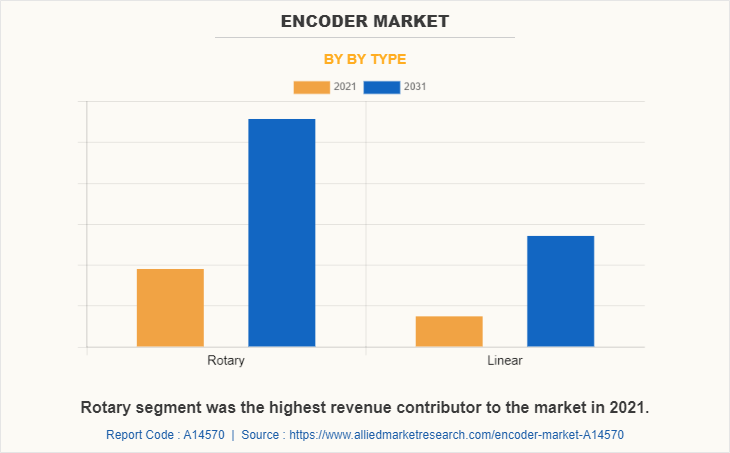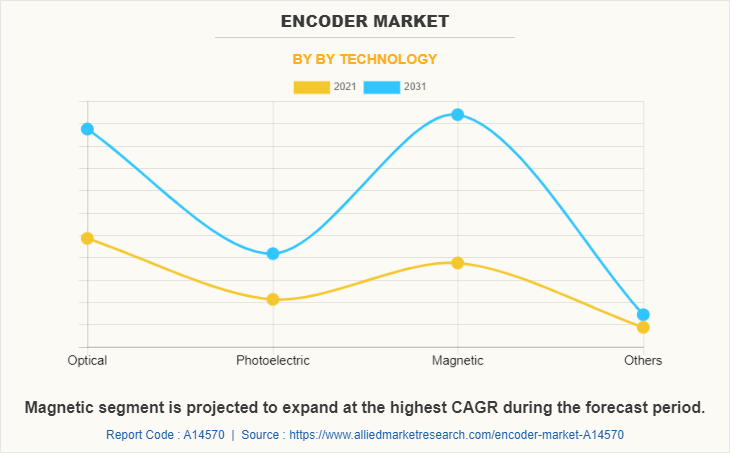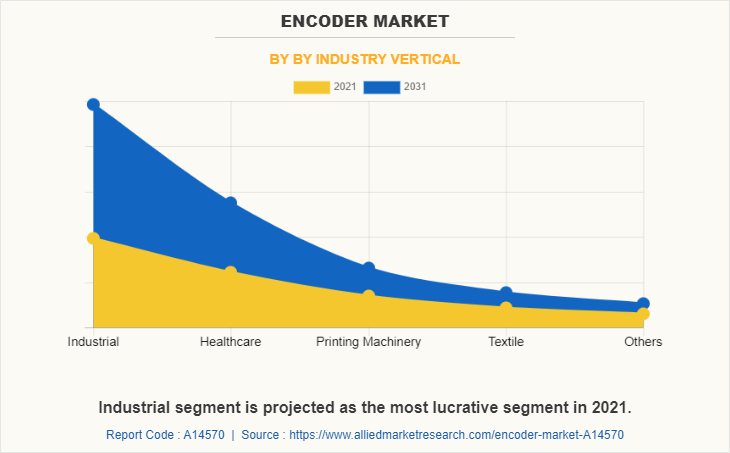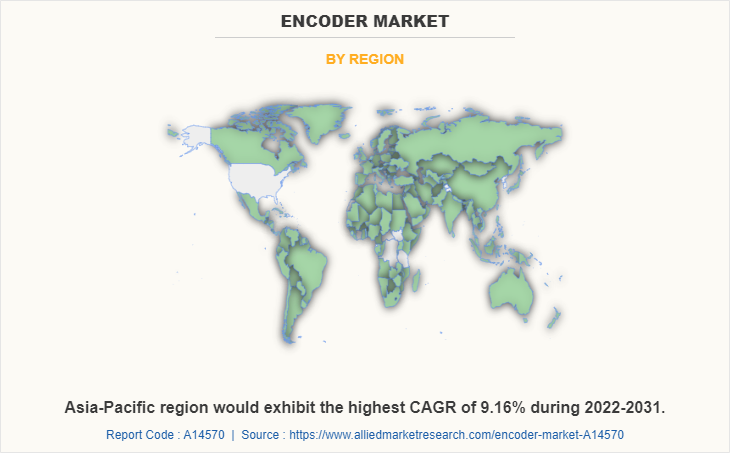Encoder Market Overview, 2031
The global encoder market was valued at $2.3 billion in 2021, and is projected to reach $5.1 billion by 2031, growing at a CAGR of 8.4% from 2022 to 2031. An encoder is a device or process that converts data from one format to another. In position sensing, an encoder is a device that can detect and convert mechanical motion to an analog or digital coded output signal. More specifically, it measures the position, while velocity, acceleration, and direction can be derived from the position, in either linear or rotary movement. Different functionality of encoders comes from different physical principles of operation, outputs, communication protocols, and more. Encoders are critical components in all kinds of mechanical systems. They are especially prevalent in industrial settings where large machinery performs repeatable tasks, high-precision prototyping or delicate work. Encoders play a vital role in the production of advanced electronics, automation industry, robotics, healthcare, and other sectors. Encoders serve the same general purpose of measuring motion and signaling feedback, but their configurations, capabilities, and applications vary widely.
Key Takeaways
- The global market study covers 20 countries. The research includes a segment analysis of each country in terms of value for the projected period.
- More than 1,500 product literatures, industry releases, annual reports, and other such documents of major market industry participants along with authentic industry journals, trade associations' releases, and government websites have been reviewed for generating high-value industry insights.
- The study integrated high-quality data, professional opinions and analysis, and critical independent perspectives. The research approach is intended to provide a balanced view of global markets and to assist stakeholders in making educated decisions to achieve their most ambitious growth objectives.
Key Market Dynamics
The need for automation by manufacturers across industries has been the key demand driver for encoders since they are used in automation to provide precise speed and direction to ensure that whatever the motor is driving runs safely and smoothly. Accurate motor speed tracking ensures optimum machine performance and operation and is designed to prevent motor burnout or machine shutdown. Thus, in automation, encoders help improve the overall equipment effectiveness (OEE) by monitoring the energy and working conditions of machines. 24/7 connectivity to production lines is also an important requirement across the food & beverage, pharmaceutical, automotive, and chemical industries. With mid-sized and large manufacturing plants implementing automation solutions, encoders are being adopted on a large scale for better utilization of assets, controlling the quality of end products, and minimization of errors.
One of the notable factors that positively affect the encoder market share include rise in adoption of encoders for communication between controls & monitoring of machines. Moreover, increase in need for high-end automation across industries is expected to drive the growth of the encoder market size. However, variations in international regulations are expected to hinder the encoder market growth. On the contrary, increasing demand for artificial intelligence-based systems is expected to offer huge market opportunities in the coming years.
Segment Overview:
The encoder market is segmented into by Type, by Technology and by Industry Vertical.

By type, the market is divided into rotary and linear. The rotary segment was the highest revenue contributor to the market in 2021.

The technology segment is divided into optical, photoelectric, magnetic, and others. The magnetic segment is expected to be the most lucrative segment during the forcast period.

The industry vertical segment is divided into industrial, healthcare, printing machinery, textile, and others. The industrial segment was the highest revenue contributor to the market in 2021.

Region-wise, the encoder market trends are analyzed across North America (the U.S., Canada, and Mexico), Europe (UK, Germany, France, Italy, Spain, Russia, Netherlands, Belgium, Poland, and rest of Europe), Asia-Pacific (China, Japan, India, South Korea, Australia, Malaysia, Thailand, Philippines, Indonesia, and rest of Asia-Pacific), and LAMEA (Latin America, the Middle East, and Africa). Asia-Pacific remains a significant participant in the global encoder industry. Major organizations and government institutions in the country are intensely putting resources into the technology.
The need for automation by manufacturers across industries has been the key demand driver for encoders since they are used in automation to provide precise speed and direction to ensure that whatever the motor is driving runs safely and smoothly. Accurate motor speed tracking ensures optimum machine performance and operation and is designed to prevent motor burnout or machine shutdown. Thus, in automation, encoders help improve the overall equipment effectiveness (OEE) by monitoring the energy and working conditions of machines. 24/7 connectivity to production lines is also an important requirement across the food & beverage, pharmaceutical, automotive, and chemical industries. With mid-sized and large manufacturing plants implementing automation solutions, encoders are being adopted on a large scale for better utilization of assets, controlling the quality of end products, and minimization of errors.
One of the notable factors that positively affect the encoder market share include rise in adoption of encoders for communication between controls & monitoring of machines. Moreover, increase in need for high-end automation across industries is expected to drive the growth of the encoder market size. However, variations in international regulations are expected to hinder the encoder market growth. On the contrary, increasing demand for artificial intelligence-based systems is expected to offer huge market opportunities in the coming years.
Regional/Country Market Outlook
- North America: The encoder market in North America is driven by the growing adoption of automation in industries such as manufacturing, automotive, and aerospace. High investment in advanced technologies and the presence of key players enhance market growth. The U.S. leads the region due to its focus on industrial IoT and robotics.
- Europe: In Europe, the encoder market is bolstered by the strong presence of automotive and industrial automation sectors. Germany, being a hub for industrial machinery, leads the region. Moreover, the push towards Industry 4.0 and energy-efficient technologies is a major driver in the region.
- Asia-Pacific: The Asia-Pacific region experiences the fastest growth in the encoder market, primarily due to rapid industrialization in countries like China, Japan, and India. Increasing investments in manufacturing, coupled with expanding consumer electronics and automotive sectors, are fueling market demand.
- LAMEA: The encoder market in LAMEA is developing, with moderate growth driven by the expansion of industrial sectors and increasing automation in manufacturing. Countries like Brazil and the UAE are witnessing rising demand due to industrial modernization efforts. However, economic challenges in certain areas may restrain growth.
Competitive analysis
Competitive analysis and profiles of the major encoder industry players and innovators such as Alps Alpine Co., Ltd., Bourns, Inc., Broadcom, CUI Devices, Dynapar, ELCO Holding, FENAC, FRABA B.V., Grayhill Inc., HEIDENHAIN, Omron Corporation, Panasonic Corporation, Rockwell Automation, Inc., Schneider Electric, Sensata Technologies, Inc., TE Connectivity, and TT Electronics are provided in this report.
Report Coverage & Deliverables
This report delivers in-depth insights into the encoder market, by type, by technology and by industry vertical, and key strategies employed by major players. It offers detailed market forecasts and emerging trends.
Type Insights
The encoder market is segmented into rotary and linear types. Rotary encoders dominate the market due to their widespread use in applications requiring angular position measurement, particularly in industrial automation and robotics. Linear encoders are also gaining traction in industries that need precise linear positioning, such as manufacturing and material handling.
Technology Insights
Encoders are classified based on technologies such as optical, photoelectric, magnetic, and others. Optical encoders hold the largest share due to their high precision and reliability. Magnetic encoders are popular for harsh environments, while photoelectric encoders are used where non-contact measurement is essential. Emerging technologies are addressing niche application demands.
Industry Vertical Insights
The encoder market serves various industries, including industrial automation, healthcare, printing machinery, and textiles. The industrial sector remains the largest consumer, driven by the need for automation and precision control. The healthcare industry is seeing growth due to the increasing use of encoders in medical devices, while the printing and textile sectors demand encoders for high-speed and accurate operations.
Regional Insights
North America and Europe lead the encoder market due to their advanced industrial infrastructure and focus on automation. Asia-Pacific is the fastest-growing region, driven by rapid industrialization in countries like China, India, and Japan. LAMEA shows steady growth, with increasing automation and industrial modernization in countries such as Brazil and the UAE, although economic challenges may limit progress.
Key Strategies and Developments
- In January 2023, SICK introduced a new family of linear encoders designed for precise piston position detection in hydraulic cylinders and monitoring linear movements in machinery. The DAX® linear encoder series offers versatile solutions for a wide range of industrial applications.
- In September 2024, Fagor Automation unveiled the H3 Angular Encoder Series, featuring models like the H3-D90, H3-D110, H3-D200i100, and S3-D90. These encoders offer external diameters from 90 mm to 200 mm and internal diameters up to 100 mm. The H3-D90 stands out as the only model on the market with a resonance frequency exceeding 1500 Hz, while the H3-D110 offers a 110 mm external diameter and a 35 mm internal diameter, providing greater flexibility and design options for machinery and equipment.
Key Benefits For Stakeholders
- This report provides a quantitative analysis of the market segments, current trends, estimations, and dynamics of the encoder market analysis from 2021 to 2031 to identify the prevailing encoder market opportunities.
- The market research is offered along with information related to key drivers, restraints, and opportunities.
- Porter's five forces analysis highlights the potency of buyers and suppliers to enable stakeholders make profit-oriented business decisions and strengthen their supplier-buyer network.
- In-depth analysis of the encoder market segmentation assists to determine the prevailing market opportunities.
- Major countries in each region are mapped according to their revenue contribution to the global market.
- Market player positioning facilitates benchmarking and provides a clear understanding of the present position of the market players.
- The report includes the analysis of the regional as well as global encoder market trends, key players, market segments, application areas, encoder market forecast and market growth strategies.
Encoder Market Report Highlights
| Aspects | Details |
| Market Size By 2031 | USD 5.1 billion |
| Growth Rate | CAGR of 8.4% |
| Forecast period | 2021 - 2031 |
| Report Pages | 266 |
| By Type |
|
| By Technology |
|
| By Industry Vertical |
|
| By Region |
|
| Key Market Players | ELCO Holding, Dynapar, Alps Alpine Co., Ltd., FENAC / Fenac Technology / Fenac Engineering, Sensata Technologies, Inc., Schneider Electric, Grayhill Inc. , TT Electronics , HEIDENHAIN, Broadcom Inc., Panasonic Corporation, Rockwell Automation, Inc., TE Connectivity, Omron Corporation, CUI Devices, FRABA B.V., Bourns, Inc. |
Analyst Review
The encoder market is expected to leverage high potential for industrial and healthcare industry verticals. The current business scenario has witnessed increase in demand for encoders, particularly in developing regions, owing to rising adoption of encoders for communication between controls & monitoring of machines. Companies in this industry have adopted various innovative techniques, such as mergers and acquisitions to strengthen their business position in the competitive matrix.
The encoder market has steadily gained traction, owing to rise in demand for enhanced technologies in high-end automation across industries and integration of IoT, AI, in different industrial applications, including manufacturing, and others.
Moreover, surge in industrialization, coupled with increasing demand for automated industrial machines and robotics are some of the additional factors anticipated to drive the market growth during the forecast period.
The key players profiled in the report include encoder market players, such as Alps Alpine Co., Ltd., Bourns, Inc., Broadcom, CUI Devices, Dynapar, ELCO Holding, FENAC, FRABA B.V., Grayhill Inc., HEIDENHAIN, Omron Corporation, Panasonic Corporation, Rockwell Automation, Inc., Schneider Electric, Sensata Technologies, Inc., TE Connectivity, and TT Electronics.
Industrial application including manufacturing, automotive and others is considered to be the leading application of Encoder Market.
Asia-Pacific region is projected to be the largest regional market for Encoder.
The global encoder market was valued at $2,312.3 million in 2021.
The top companies to hold the market share in Encoder are Alps Alpine Co., Ltd., Bourns, Inc., Broadcom, CUI Devices, Dynapar, ELCO Holding, FENAC, FRABA B.V. and others.
The Encoder Market is expected to grow at a CAGR of 8.41 % during the forecast period.
Loading Table Of Content...




